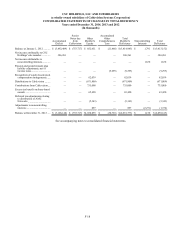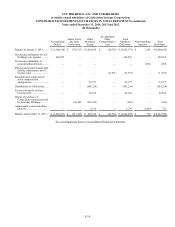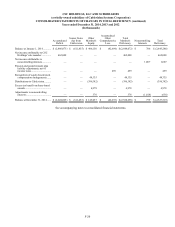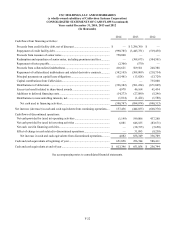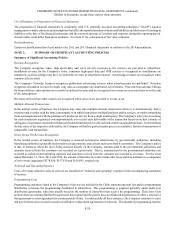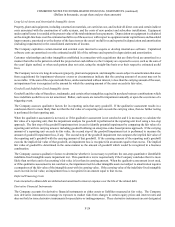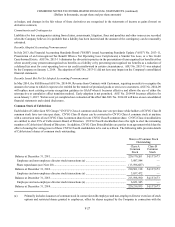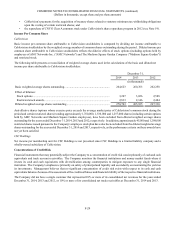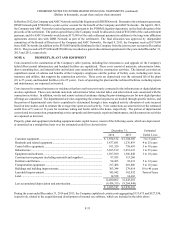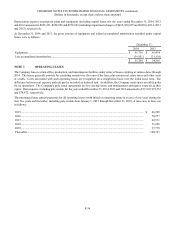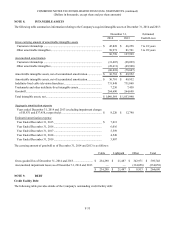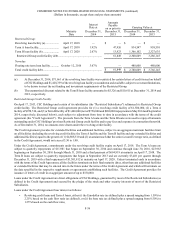Cablevision 2014 Annual Report Download - page 115
Download and view the complete annual report
Please find page 115 of the 2014 Cablevision annual report below. You can navigate through the pages in the report by either clicking on the pages listed below, or by using the keyword search tool below to find specific information within the annual report.COMBINED NOTES TO CONSOLIDATED FINANCIAL STATEMENTS (continued)
(Dollars in thousands, except share and per share amounts)
F-26
Long-Lived Assets and Amortizable Intangible Assets
Property, plant and equipment, including construction materials, are carried at cost, and include all direct costs and certain indirect
costs associated with the construction of cable systems, and the costs of new product and subscriber installations. Equipment
under capital leases is recorded at the present value of the total minimum lease payments. Depreciation on equipment is calculated
on the straight-line basis over the estimated useful lives of the assets or, with respect to equipment under capital leases and leasehold
improvements, amortized over the shorter of the lease term or the assets' useful lives and reported in depreciation and amortization
(including impairments) in the consolidated statements of income.
The Company capitalizes certain internal and external costs incurred to acquire or develop internal-use software. Capitalized
software costs are amortized over the estimated useful life of the software and reported in depreciation and amortization.
Customer relationships and other intangibles established in connection with acquisitions that are finite-lived are amortized in a
manner that reflects the pattern in which the projected net cash inflows to the Company are expected to occur, such as the sum of
the years' digits method, or when such pattern does not exist, using the straight-line basis over their respective estimated useful
lives.
The Company reviews its long-lived assets (property, plant and equipment, and intangible assets subject to amortization that arose
from acquisitions) for impairment whenever events or circumstances indicate that the carrying amount of an asset may not be
recoverable. If the sum of the expected cash flows, undiscounted and without interest, is less than the carrying amount of the asset,
an impairment loss is recognized as the amount by which the carrying amount of the asset exceeds its fair value.
Goodwill and Indefinite-Lived Intangible Assets
Goodwill and the value of franchises, trademarks, and certain other intangibles acquired in purchase business combinations which
have indefinite useful lives are not amortized. Rather, such assets are tested for impairment annually or upon the occurrence of a
triggering event.
The Company assesses qualitative factors for its reporting units that carry goodwill. If the qualitative assessment results in a
conclusion that it is more likely than not that the fair value of a reporting unit exceeds the carrying value, then no further testing
is performed for that reporting unit.
When the qualitative assessment is not used, or if the qualitative assessment is not conclusive and it is necessary to calculate the
fair value of a reporting unit, then the impairment analysis for goodwill is performed at the reporting unit level using a two-step
approach. The first step of the goodwill impairment test is used to identify potential impairment by comparing the fair value of a
reporting unit with its carrying amount, including goodwill utilizing an enterprise-value based premise approach. If the carrying
amount of a reporting unit exceeds its fair value, the second step of the goodwill impairment test is performed to measure the
amount of goodwill impairment loss, if any. The second step of the goodwill impairment test compares the implied fair value of
the reporting unit's goodwill with the carrying amount of that goodwill. If the carrying amount of the reporting unit's goodwill
exceeds the implied fair value of that goodwill, an impairment loss is recognized in an amount equal to that excess. The implied
fair value of goodwill is determined in the same manner as the amount of goodwill which would be recognized in a business
combination.
The Company assesses qualitative factors to determine whether it is necessary to perform the one-step quantitative identifiable
indefinite-lived intangible assets impairment test. This quantitative test is required only if the Company concludes that it is more
likely than not that a unit of accounting’s fair value is less than its carrying amount. When the qualitative assessment is not used,
or if the qualitative assessment is not conclusive, the impairment test for other intangible assets not subject to amortization requires
a comparison of the fair value of the intangible asset with its carrying value. If the carrying value of the indefinite-lived intangible
asset exceeds its fair value, an impairment loss is recognized in an amount equal to that excess.
Deferred Financing Costs
Costs incurred to obtain debt are deferred and amortized to interest expense over the life of the related debt.
Derivative Financial Instruments
The Company accounts for derivative financial instruments as either assets or liabilities measured at fair value. The Company
uses derivative instruments to manage its exposure to market risks from changes in certain equity prices and interest rates and
does not hold or issue derivative instruments for speculative or trading purposes. These derivative instruments are not designated




